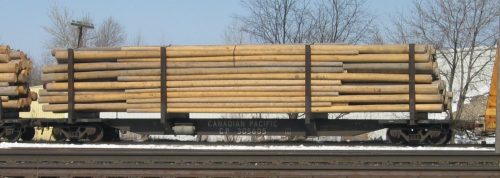This unique Canadian Pacific skeleton flat is a new model I just finished* this week.
*(Assembly, paint and decals; still needs clear coat and weathering.)
The model is a Custom Finishing kit, which is made up of a series of soft metal (pewter) casting. After cleaning up all the parts with a fine file, and drilling holes for grab irons and truck and coupler box mounting screws, the model was assembled per the kit instructions using two part epoxy to glue the major parts together. As there’s barely a dozen pieces, it’s actually a very easy and straightforward build. I also drilled through the joint at each end between the main spine of the car and the end platforms and pinned it with a short piece of wire to reinforce the joint, so that the main structural pieces aren’t only held together by the epoxy. One extra addition I made was to apply 1×10 plates for the KarTrack ACI barcode labels on the right-most stake on each side, and I also drilled holes in the end sills to mount Kadee #438 air hoses.
With the assembly completed, the model was airbrushed black and lettered with decals from Black Cat Publishing specifically for this car. ACI labels came from a MicroScale set, and a couple of missing elements (“Plate C” marking and NSC builder’s logo) were added from a Highball CP Rail flatcar set.
The prototype for this car is one of 50 cars built in September 1968 by National Steel Car as CP 305560-305609. (Another 300 identical cars were built for Pacific Great Eastern in two batches in 1966 and 1968.) The cars were designed for use transporting full length logs and poles.
I’ve heard some mention of shipments of telephone poles to the Sault Public Utilities Commission; I’m not sure where such shipments would be unloaded, but all that is needed is a team track with a driveway beside it. Whether such movements actually happened with any regularity, the “rule of cool” applies here a little as well, and that’s what the waybill for this car will show when it runs on my eventual layout.
Just need to make a (removable) pole load for this car now…




